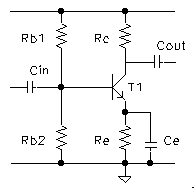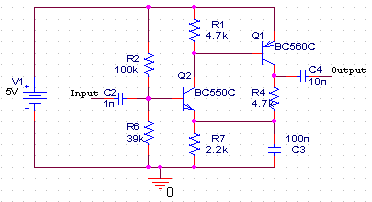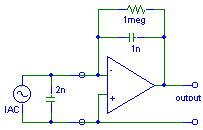The pre-amplifier can either be realised either using single transistors or with opamps.
The 'front-end' of the detector needs to be extremely low noise, because signal levels are very low. A simple transistor amplifier is supposedly better than an opamp, even a low-noise one.
All transistor microphone pre-amplifier
 This pre-amplifier was recommended in the article that describes
this TCA440 detector.
This pre-amplifier was recommended in the article that describes
this TCA440 detector. "
De microfoon heeft een hoge gevoeligheid voor het audiogebied,
maar in het ultrasone gebied neemt de gevoeligheid snel af.
De ontvanger is erg gevoelig.
Om oversturing en rondzingen door de hoge gevoeligheid
van de microfoon in het audiogebied te voorkomen,
moet de versterking van de microfoonversterker voor het audiogebied laag zijn
en toenemen met de frequentie in het ultrasone gebied.
"
De microfoon heeft een hoge gevoeligheid voor het audiogebied,
maar in het ultrasone gebied neemt de gevoeligheid snel af.
De ontvanger is erg gevoelig.
Om oversturing en rondzingen door de hoge gevoeligheid
van de microfoon in het audiogebied te voorkomen,
moet de versterking van de microfoonversterker voor het audiogebied laag zijn
en toenemen met de frequentie in het ultrasone gebied.
De eigenruis van de versterker dient zo laag mogelijk te zijn. De onderstaande versterker voldoet aan deze eis: De versterking is bij 10 kHz: 6 dB, bij 20 kHz: 24 dB en bij 100 kHz: 50 dB. "
English:
" The microphone has high sensitivity in the audio range, but in the ultrasonic range, the sensitivity decreases rapidly. The receiver is very sensitive. To prevent overdriving and feedback due to the high sensitivity of the microphone in the audio range, the gain of the amplifier should be low in the audio range and increase with frequency in the ultrasonic range. The intrinsic noise of the amplifier should be as low as possible. The amplifier below satifies this requirement: The gain at 10 kHz is: 6 dB, at 20 kHz: 24 dB and at 100 kHz: 50 dB. "
High-pass filter
 This is a circuit sent to me to reduce problems with low-frequency cross-talk
in a heterodyne detector using an electret microphone for a TCA440 detector.
Nice features are the 3rd order filtering and the symmetric output.
This is a circuit sent to me to reduce problems with low-frequency cross-talk
in a heterodyne detector using an electret microphone for a TCA440 detector.
Nice features are the 3rd order filtering and the symmetric output.The filter structure is a so-called Sallen-Key filter. It looks just like a cascade of three simple RC stages, except the R of the middle stage is connected to the output instead of ground, which results in a sharper cut-off.
The output of the circuit is symmetric. Any variation on the input will show up as a positive variation on the emitter and a negative variation on the collector (since Re and Rc are equal), making for a total gain of 2.
A possible disadvantage of this circuit could be its noise-performance, but the circuit is meant to be used with an electret microphone, so the noise performance is probably already dominated by the built-in transistor (FET) inside the microphone.
Using a transistor for amplification
A single transistor can be used to give gains up to about 100. Also you can build a +6 dB/octave slope in the gain curve relatively easy. Shown is a relatively standard way of connecting a transistor.A transistor acts like a current controlled current source. The current through the collector (ic) is hfe times the current through the base (ib). It could also be regarded as a voltage controlled current source. In this case, the input voltage is the voltage between base and emitter (vbe). The current rises sharply for voltages above approximately 0.6 V, causing the potential difference between emitter and collector to be about 0.6V for normal operation. For the BC547 (and BC550), a common transistor, the current amplification factor hfe is equal to approx. 250.
 To amplify a small AC signal, the following circuit can be used:
To amplify a small AC signal, the following circuit can be used:
The input signal is fed through Cin into the base of the transistor.
Resistors Rb1 and Rb2 are used as a voltage divider
to force a bias voltage on the base connection of the transistor.
Resistor Re acts as a stabilising element, causing the emitter
voltage to be about 0.6V lower than the base voltage.
The emitter voltage divided by the emitter resistance gives you the
bias current.
The output signal is taken from the collector of the transistor through
capacitor Cout.
 First the current through the transistor is chosen, which influences the
so-called steepness of the transistor.
A value of 1 mA is a good example I think.
The steepness of the transistor is approximately equal to 40 times the current.
A high current means a low input impedance (hfe/s),
which is bad,
but also means a high voltage amplification (equal to sRc).
First the current through the transistor is chosen, which influences the
so-called steepness of the transistor.
A value of 1 mA is a good example I think.
The steepness of the transistor is approximately equal to 40 times the current.
A high current means a low input impedance (hfe/s),
which is bad,
but also means a high voltage amplification (equal to sRc).
Example
I used the following component values in a prototype of my bat detector: Rb1=100k, Rb2=27k, Re=1k, Rc=5k6 and Ce=10n.Rb1 and Rb2 set the voltage at the base of the transistor at 1.28 V (6V supply voltage). The voltage at the emitter is 0.6 V lower at 0.68 V. This voltage divided by Re gives you the emitter current of 0.68 mA. The steepness s of the transistor is approx. 40 times the emitter current so it is equal to 0.027.
For low frequencies the gain will be approx. Rc/Re=5.4. From 16 kHz upwards the gain increases with 20 dB/decade. At high frequencies the gain will be limited by things like the base-emitter capacitance, amplified by the Miller-effect.
Please note that these calculations are approximations !
Another example
 A slightly more complicated circuit is shown on the right.
A slightly more complicated circuit is shown on the right.The gain is boosted by another transistor and resistor.
The analysis of this circuit is more complicated. The two resistors connected to the base of the left transistor still set the base bias voltage (at about 1.4V), resulting in a emitter voltage of 0.8V. The emitter voltage sets the total current through both transistors to about (0.8V / 2200ohm) = 0.36 mA.
The current through the left transistor is set by the collector resistor (4k7) and the base-emitter drop of the right transistor (0.6V) : I=0.6/4700=0.13 mA.
Charge mode amplifier
 It has been suggested to me to use a charge mode amplifier in combination with a piezo-
electric transducer.
This type of amplifier is supposed give a flat response up until the resonant frequency.
It has been suggested to me to use a charge mode amplifier in combination with a piezo-
electric transducer.
This type of amplifier is supposed give a flat response up until the resonant frequency.It looks like the schematic on the right.
The model for a piezo-electric transducer is now a current source, parallelled by a capacitance.
I also found the following example at a company called Amp:
Interfacing piezo film to electronics
This page was last updated May 17th, 2009